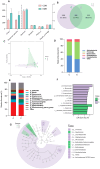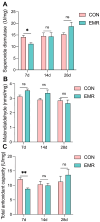Alterations in the Intestinal Microbiome and Metabolic Profile of British Shorthair Kittens Fed with Milk Replacer
- PMID: 39199879
- PMCID: PMC11350904
- DOI: 10.3390/ani14162346
Alterations in the Intestinal Microbiome and Metabolic Profile of British Shorthair Kittens Fed with Milk Replacer
Abstract
With the rising popularity of pet cats as companion animals, the survival of newborn kittens is often threatened by factors such as inadequate nursing, maternal behavior and blood incompatibility. These challenges require the use of milk replacers for nurturing. To investigate the effects that feeding kittens with an experimental milk replacer (EMR) have on growth and development, intestinal microbiota, immune response and nutrient metabolism, 12 British shorthair kittens were randomly divided into two groups after nursing for the first week of life. Kittens were fed queen's milk or EMR, whereby kittens fed queen's milk served as the control (CON) group. The findings revealed that the CON group exhibited superoxide dismutase (SOD) activity and total antioxidant capacity (T-AOC) (p < 0.01) on day 7. However, the EMR group had better growth performance during the later stage of the experiment (p < 0.05); the immunocompetence and antioxidant capacity of the EMR group were not significantly different from those of the CON group in the middle and late stages of the experiment, and the mean values of all the indexes were slightly better than those of the control group. Sequencing of the 16S rRNA gene in microbiota demonstrated that EMR increased the colonization of bacterial genera, including Lachnospiraceae, Enterococcus, Rothia and Ligilactobacillus. Compared to the CON group, acetate acid (p < 0.05), propionate acid (p < 0.01) and total SCFAs (p < 0.01) in the EMR group were significantly increased. Moreover, the intake of the EMR resulted in the production of distinct metabolites implicated in the metabolism of lipids and amino acids, among other nutrients, thus invigorating the associated metabolic pathways. These results elucidate the impact of administering a milk replacer on gastrointestinal health and nutrient assimilation in kittens. The study provides insights into the use of milk powder alternatives and sets the stage for future research on the formulation and effectiveness of kitten milk replacers.
Keywords: cat; gut microbiota; metabolic pathways; metabolomics; microbiome; milk replacer.
Conflict of interest statement
The authors declare no conflicts of interest.
Figures






Similar articles
-
Comparison of kittens fed queen's milk with those fed milk replacers.Am J Vet Res. 1993 Jun;54(6):901-7. Am J Vet Res. 1993. PMID: 8323060
-
Early-life milk replacer feeding mediates lipid metabolism disorders induced by colonic microbiota and bile acid profiles to reduce body weight in goat model.J Anim Sci Biotechnol. 2024 Sep 4;15(1):118. doi: 10.1186/s40104-024-01072-x. J Anim Sci Biotechnol. 2024. PMID: 39227902 Free PMC article.
-
Effects of milk, milk replacer, and milk replacer plus ethoxyquin on the growth performance, weaning stress, and the fecal microbiota of Holstein dairy calves.Front Microbiol. 2023 Mar 13;14:1113518. doi: 10.3389/fmicb.2023.1113518. eCollection 2023. Front Microbiol. 2023. PMID: 36992934 Free PMC article.
-
A 100-Year Review: Calf nutrition and management.J Dairy Sci. 2017 Dec;100(12):10151-10172. doi: 10.3168/jds.2017-13062. J Dairy Sci. 2017. PMID: 29153160 Review.
-
Pediatric nutrition.Vet Clin North Am Small Anim Pract. 2014 Mar;44(2):265-73. doi: 10.1016/j.cvsm.2013.11.001. Epub 2013 Dec 25. Vet Clin North Am Small Anim Pract. 2014. PMID: 24580990 Review.
Cited by
-
Dynamic development of gut microbiota and metabolism during and after weaning of kittens.Anim Microbiome. 2025 Jan 18;7(1):10. doi: 10.1186/s42523-024-00373-w. Anim Microbiome. 2025. PMID: 39827164 Free PMC article.
References
-
- Mori E., Menchetti M., Camporesi A., Cavigioli L., Tabarelli De Fatis K., Girardello M. License to Kill? Domestic Cats Affect a Wide Range of Native Fauna in a Highly Biodiverse Mediterranean Country. Front. Ecol. Evol. 2019;7:477. doi: 10.3389/fevo.2019.00477. - DOI
-
- Fournier A., Masson M., Corbière F., Mila H., Mariani C., Grellet A., Chastant-Maillard S. Epidemiological Analysis of Reproductive Performances and Kitten Mortality Rates in 5303 Purebred Queens of 45 Different Breeds and 28,065 Kittens in France. Reprod. Domest. Anim. 2017;52:153–157. doi: 10.1111/rda.12844. - DOI - PubMed
LinkOut - more resources
Full Text Sources
Miscellaneous

